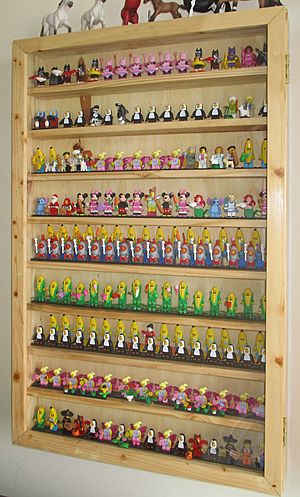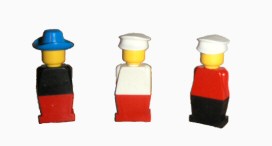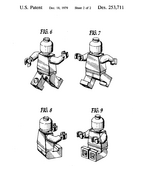Lego minifigure facts for kids
A Lego minifigure, often called a minifig, is a small plastic toy figure. It has parts that can move, like arms and legs. These figures are made by The Lego Group, a toy company from Denmark. Minifigures first came out in 1978. They have been very popular, with over 4 billion made by 2020!
You usually find minifigures inside Lego sets. But you can also buy them separately as collectables in mystery bags. Some Lego stores even let you build your own custom minifigure. Many minifigures are designed to fit a certain Lego theme, like police officers, astronauts, or pirates. Others are specific characters from movies, TV shows, or video games. Both kids and adults enjoy collecting minifigures. You can easily mix and match parts from different figures to create many new combinations.
Other companies also make similar figures. Some examples are Kreons from Kre-O toys, or figures from Block Tech and Mega Bloks. Lego also makes other types of figures, like Duplo figures and mini-doll figures.
Contents
The History of Lego Minifigures
Before the modern minifigure, Lego released an early version in 1975. These figures were the same size as today's minifigures. However, they looked different. They had solid bodies without separate moving arms or legs. Their heads also had no printed faces. They came with a few different headpieces, like caps or hats.
The first modern minifigures came out in 1978. They were included in Castle, Space, and Town sets. Jens Nygaard Knudsen designed them. He had the clever idea to make the torsos, legs, and arms interchangeable. Lego decided to give them a simple face: two black dots for eyes and a black smile. This simple design allowed kids to imagine the figure's gender or background.
In 1989, the Lego Pirates theme introduced new minifigure parts. These included hooks for hands and peg legs. This was the first time minifigures had parts different from the usual ones. Soon after, Lego started adding more facial expressions. These included beards, eye patches, or sunglasses. In 1997, faces became even more detailed. They started showing open mouths and more complex eyes.
Other leg variations appeared later. Some figures had spring-loaded legs, but these were only in basketball sets from 2002–2003. Lego also made short legs for child or dwarf characters. Long legs were used for characters in the Toy Story theme.
In 2003, Lego released minifigures with natural skin tones for the first time. Before this, all minifigures had yellow skin. These new figures were part of the Lego Basketball theme. They looked like real people. The Lando Calrissian minifigure in the Star Wars theme also had a natural skin tone. By 2004, all licensed Lego products used natural skin tones. This meant figures representing actors or real people had realistic skin colors. Popular examples include figures from Star Wars, Indiana Jones, Harry Potter, and Batman.
By 2006, Lego had made about 4 billion minifigures. Between 1975 and 2010, there were at least 3,655 different minifigures. The number of new minifigures released each year keeps growing fast. In 2010 alone, over 300 new minifigures were introduced!
How Minifigures Are Designed and Built
A typical minifigure is about 4 centimeters (1.6 inches) tall. Minifigures usually have six main parts. These are the head, torso, hips, arms, hands, and legs. These parts allow the figure to move in seven places. The head can turn, the arms can swing, the wrists can twist, and the legs can move. When you buy a Lego set, minifigures are often packaged in three separate parts: head, torso, and legs. The plastic used is called acrylonitrile butadiene styrene (ABS). This is a very strong material that makes Lego figures durable.
The plastic is melted and poured into special molds. These molds create the different parts of the minifigure. Some molds also create accessories like swords, guns, or everyday items like cups. Most heads and torsos need extra decoration, and sometimes the arms and legs do too. This detailed printing process is why minifigures can be more expensive than other Lego products. After printing, the head is placed on the torso, the legs are attached, and the arms are snapped on. Finally, the figures are put into bags and made ready for sale.
How Minifigures Are Used
Minifigure heads are round and fit onto a small cylinder on top of the torso. This allows the head to spin around. This design also lets you attach other items over the torso, like air tanks, capes, or armor. The top of the head has a stud, just like a standard Lego brick. This means you can place other Lego pieces on top of a minifigure's head. Blank minifigure heads are sometimes used in Lego sets to create other objects, like lampshades.
There are many different head accessories, including hair, helmets, and hats. The legs can swing forward 90 degrees and backward almost 45 degrees. Minifigures can connect to standard Lego bricks whether they are sitting or standing. A minifigure's hands look like the letter "C." This shape allows them to hold many Lego accessories, such as swords, axes, wands, cups, guns, and lightsabers. Also, the tops of the hands are about the same size as Lego studs. This means you can place Lego pieces on top of their hands. All these options allow you to customize minifigures, fitting with Lego's modular design.
Images for kids
-
Aluminum minifigures on board the Juno spacecraft: (left to right) Jupiter, Juno, and Galileo
See also
 In Spanish: Minifigura para niños
In Spanish: Minifigura para niños







